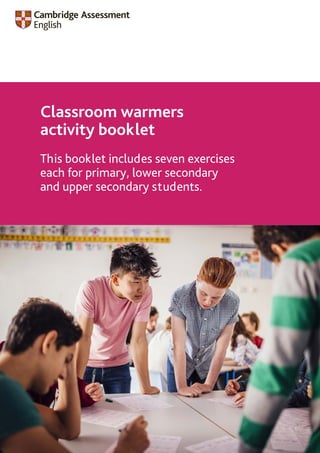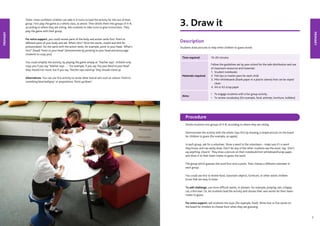This document provides details on seven warm-up activities for language classrooms at different levels: primary, lower secondary, and upper secondary. The activities include animal mimes, Simon Says-style movement games, drawing pictures to describe words, counting questions, word scrambles, memory games, and pretend ball games reviewing vocabulary or grammar. Most activities can be adapted to different ability levels and lexical topics. The warm-ups aim to engage students physically and review essential language concepts in a fun, collaborative way.


![4 5
1. Animal mimes
Description
Students mime animals for each other to guess.
Time required: 10–20 minutes
Materials required:
(Optional) animal pictures –
you could use the Pre A1 Starters flash cards
Aims:
• To engage students with a fun, physical activity
• To review animal vocabulary
Procedure
Model the activity. Say: ‘What animal am I?’ Choose an animal and mime it, making the
animal noise if you like (younger children will enjoy this!). When someone guesses it, say
‘Well done! It’s your turn!’ Ask them to choose an animal (or give them an easy one to mime
and make the noise if they want (lion for example) for the rest of the class to guess.
Divide students into groups of 4–8, according to where they are sitting.
Students take it in turns to choose their own animals
to mime for the rest of their group.
Confident students can mime for the
whole class.
To add challenge, students could
describe the word to give extra clues. For
example, for cat they could say ‘Four legs’,
‘It eats fish’ or ‘It is a pet’.
For extra support, you could display animal
flash cards on the board and elicit the animal
words first, helping with words children
find difficult to pronounce. You could give a
student an animal to mime if they struggle to
think of one by themselves – write it on a piece
of paper or show (don’t give) them an animal
flash card so no one else can see.
Alternatives: You can use this activity to revise other lexical sets which can be mimed, for
example jobs, sports, adjectives, hobbies.
2. Teacher says
Description
Students listen and move according to the teacher’s instructions. This is similar to Simon says, but
students need to listen carefully and do what you say (not always what you do!).
Time required: 10–15 minutes
Materials required: None
Aims:
• To engage students with a fun, physical activity
• To review parts of the body and action verbs
Procedure
Model the activity. Say: ‘Listen. Do what I say.’ Give some simple instructions and show the
corresponding movements at the same time. See examples below.
Now say: ‘Listen carefully. Do what I say.’
Point to your head, but say: ‘Point to your hand.’ If students point to their heads, repeat the
instruction, until they all point to their hands.
Continue playing the game, encouraging children to listen carefully. Sometimes make the
action the same as your instructions, and sometimes make it different – for example, say
‘Hold up one finger’ but hold up two. Keep it light and fun – it’s not a test and part of the fun
is that it’s difficult to follow a spoken instruction that is different from the action you see!
Example instructions: Use vocabulary your students are familiar with.
Point to your [nose/head/eyes, etc.]
Hold up [2] fingers.
Show me your [hands/fingers, etc.]
Stand up.
Sit down.
To add challenge, you could make your instructions more difficult, for example, ‘Clap your
hands five times’. You could use more challenging vocabulary, for example: chest, stomach,
neck, nod/shake your head, smile, wave, etc.
PRIMARY
PRIMARY
](https://image.slidesharecdn.com/594825-classroom-warmers-activity-booklet-230809235356-e8638570/85/594825-classroom-warmers-activity-booklet-pdf-3-320.jpg)

![8
4. Quiz: How many?
Description
Students answer questions that involve counting.
Time required: 10–20 minutes
Materials required:
(Optional) numbers flash cards – you could use pages 42–43 in Pre A1
Starters flash cards
• One student in each group uses their own notebook and felt tip or
marker pen to write the answers
• If you do this as a whole-class activity, each student should use their
own notebook and pen to write
Aims:
• To engage students with a fun, collaborative activity
• To review numbers
Procedure
Ask a couple of simple ‘How many’ questions for the whole class to answer. For
example, you could ask what they can see in the classroom: ‘How
many teachers are there?’ (one) ‘How many
windows are there?’
Divide students into pairs or groups of
3–4, according to where they are sitting.
Say: ‘Who will write?’ Make sure they
have writing materials (see Materials
required).
Display ‘How many?’ questions on the
board, one at a time. Say: ‘Work together.
Write your answer.’ Give students a little
time to think, discuss and write the answer
on their scrap paper or mini whiteboard. Make
sure they write their number nice and big. You
could show a countdown timer.
Then, count down ‘Three, two, one, show me!’ The children hold up the numbers they wrote
at the same time. Confirm correct answers (depending on the questions, answers might be
different for different groups). Move to the next question.
Choose questions according to the level of your students. Examples:
Easier questions
How many children/girls/boys are in
your group?
How many pencils/pens/bags are on
your table?
How many fingers/eyes/feet have you
got?
How many clocks/doors/people are
there [in the classroom]?
More challenging questions
How many legs does a cat/do two dogs/
cats have?
How many eyes/noses/hands are there
in your group?
Plus, other questions based on what all
the children can see.
To add challenge, students could try asking their own ‘How many?’ questions. Include
higher numbers, up to 20 (or higher, if your students know them).
For extra support for younger, lower level students, you might want to review numbers
first – use flash cards to elicit and check understanding. Model and drill the numbers. Ask
children to count to 10. Check understanding by holding up your fingers and asking ‘How
many?’ When you check answers to the How many? questions, encourage the children to
count together: ‘How many heads are there in your group? Let’s count. One, two, three, four.
Four heads!’
Alternatives: Do this as a whole-class activity. All the children hold up the numbers they
wrote at the same time.
PRIMARY
PRIMARY
9
](https://image.slidesharecdn.com/594825-classroom-warmers-activity-booklet-230809235356-e8638570/85/594825-classroom-warmers-activity-booklet-pdf-5-320.jpg)


![14 15
To add challenge, you can throw other invisible balls at the same time. Or, ask children to
repeat the word(s) they heard before saying their own word. For example:
Student 1: red
Student 2: red, blue
Student 3: blue, yellow (or red, blue, yellow)
You could also change the pretend ball. For example, say: ‘New ball! Can you catch this really
heavy ball? Show me.’ or ‘New ball! This ball is really small. Show me how you catch a really
small ball.’
My favourite …
Model the activity by saying a sentence, for example: ‘My favourite food is cake.’ Then throw
your virtual ball to a student. They catch it and say: ‘My favourite food is …’ They throw the
ball to another student who says their favourite food, and so on.
To add challenge, you can throw other invisible balls at the same time.
For extra support, write the sentence starter on the board e.g. My favourite food is …
I like …
You could ask the student catching the ball to repeat what the thrower said, before saying
their answer. For example:
Student 1: ‘My name’s Claire and I like cats.’ (throws ball)
Student 2 (catching): ‘Claire likes cats. My name’s Hiam and I like football.’ (throws ball)
Student 3 (catching): ‘Claire likes cats. Hiam likes football. My name’s Sami and I like playing
computer games.’ (throws ball)
For extra support, just ask them to say their own sentence. Write I like … on the board.
Question/answer
Tell the student throwing the ball to ask a question, and the student who catches it has to
answer. For example:
Student 1 (throwing): ‘Do you like chocolate?’
Student 2 (catching): ‘Yes, I do!’ (throwing) ‘Do you like strawberries?’
Student 3 (catching): ‘No, I don’t!’ (throwing) ‘Do you like pizza?’
To add challenge, students think of their own questions.
For extra support, make the question the same each time. You could write it on the board.
Alternatives: You can use this activity to review or recycle any lexical set or language
structure, or as a ‘getting to know you activity’ (to learn names, etc.).
1. Think of five things
Description
Students play a competitive vocabulary game.
Time required: 10–20 minutes
Materials required: Each student can use their own notebook and pen
Aims:
• To engage students with a fun, competitive activity
• To review vocabulary
Procedure
Divide students into four groups, according to where they are sitting. Give each group a
category. For example:
Things that are red/green/blue etc.
Things you find in a classroom/kitchen/bedroom.
Say: ‘Think of five things. Write them down.’ Everyone in the group should write the same list.
For example, things that are red: tomato, blood, stop light, lips, etc. Tell them that the other
students are going to try to guess what they wrote, so they should try to think of things
that are not obvious.
To play the game, work as a whole class. Ask one group to be quiz masters (the group who
will ask the questions). They say their colour (e.g. blue) and then ask the other groups in turn
to say one thing that is [blue]. As the groups guess, the quizmasters listen and tick the things
their classmates guess from their list that they created at the planning stage. Allow a few
minutes for this. Monitor to make sure they ask a different person each time.
At the end of the time, the quizmasters get one point for each word on their list that their
classmates didn’t guess.
Repeat, with a different group as quizmaster each time. The team with the most points wins.
To add challenge, ask students to think of 10 things.
For extra support, instead of asking students to think of things ‘on the spot’, give them
time to brainstorm (1–2 minutes).
Alternative: Get them to choose their own category from a list.
LOWER
SECONDARY
PRIMARY
](https://image.slidesharecdn.com/594825-classroom-warmers-activity-booklet-230809235356-e8638570/85/594825-classroom-warmers-activity-booklet-pdf-8-320.jpg)









